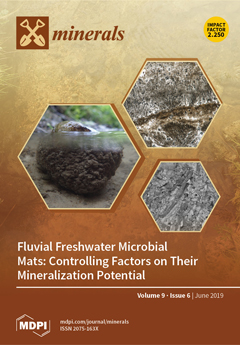The crystal structure of paratooite-(La) has been solved using crystals from the type locality, Paratoo copper mine, near Yunta, Olary Province, South Australia, Australia. The mineral is orthorhombic,
Pbam,
a = 7.2250(3) Å,
b = 12.7626(5) Å,
c = 10.0559(4) Å,
V = 927.25(6) Å
3, and
R1 = 0.063 for 1299 unique observed reflections. The crystal structure contains eight symmetrically independent cation sites. The
La site, which accommodates rare earth elements (REEs), but also contains Sr and Ca, has a tenfold coordination by seven carbonate groups. The Ca, Na1, and Na2 sites are coordinated by eight, eight, and six O atoms, respectively, forming distorted CaO
8 and Na1O
8 cubes, and Na
2O
6 octahedra. The Cu site is occupied solely by copper and possess a distorted octahedral coordination with four short (1.941 Å) and two longer (2.676 Å) apical Cu–O bonds. There are three symmetrically independent carbonate groups (CO
3)
2− with the average <C–O> bond lengths equal to 1.279, 1.280, and 1.279 Å for the C1, C2, and C3 sites, respectively. The crystal structure of paratooite-(La) can be described as a strongly distorted body-centered lattice formed by metal cations with (CO
3)
2− groups filling its interstices. According to the chemical and crystal-structure data, the crystal-chemical formula of paratooite-(La) can be described as (La
0.74Ca
0.11Sr
0.07)
4CuCa(Na
0.75Ca
0.15)(Na
0.63)(CO
3)
8 or REE
2.96Ca
1.59Na
1.38CuSr
0.28(CO
3)
8. The idealized formula can be written as (La,Sr,Ca)
4CuCa(Na,Ca)
2(CO
3)
8. The structure of paratooite is a 1 × 2 × 2 superstructure of carbocernaite, CaSr(CO
3)
2. The superstructure arises due to the ordering of the chemically different Cu
2+ cations, on one hand, and Na
+ and Ca
2+ cations, on the other hand. The formation of a superstructure due to the cation ordering in paratooite-(La) compared to carbocernaite results in the multiple increase of structural complexity per unit cell. Therefore, paratooite-(La) versus carbocernaite represents a good example of structural complexity increasing due to the increasing chemical complexity controlled by different electronic properties of mineral-forming chemical elements (transitional versus alkali and alkaline earth metals).
Full article





